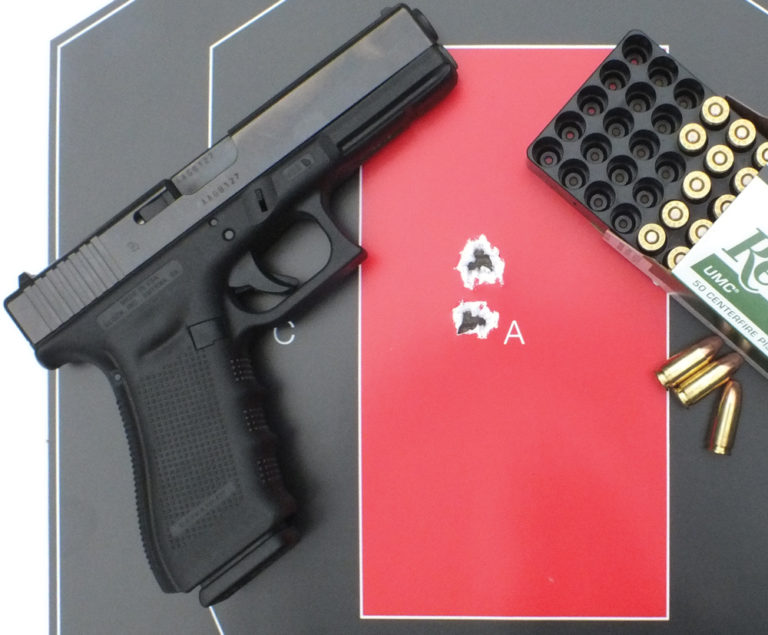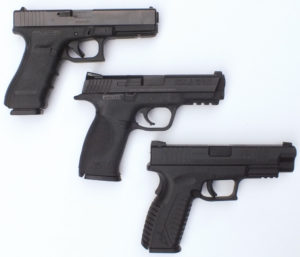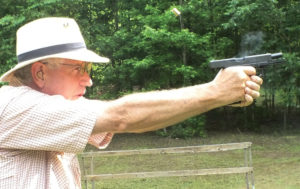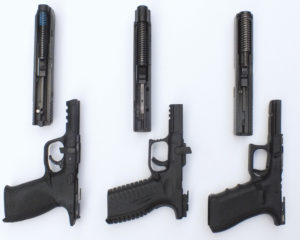
A range test with three popular striker-fired pistols – Glock 17, Smith & Wesson M&P and Springfield XDm – reveals how this design became a winner.

Currently, there are three primary striker-fired pistols in contention for the service pistol market. There are other notable guns, but for this comparison, I’m covering the guns with the biggest sales numbers. I chose 9mm as the caliber because, in recent times, 9mm Luger, with the excellent loadings we now have available, has regained popularity with law enforcement agencies as a good combination of manageability and power.
Of the three guns, the Glock was the most compact, the XDm the least, but the differences were fairly minor. All the guns in the test are basic models as would likely be chosen by both civilians and agencies.
First for similarities is the fact that all the guns in the test use a polymer frame. All have nonadjustable rear sights that can be adjusted for wind within a dovetail. All have safety triggers that require complete coverage of the trigger before the gun will fire. All use double-stack, high-capacity magazines with witness holes to allow an external round count.
The Glock and M&P have 17 round capacities, and the XDm holds 19. All three guns have a forward rail for mounting lasers or lights, and all have interchangeable back-straps to fit them better to the user’s hand. All three guns are easy to field strip and clean.
The guns were accuracy tested and several hundred rounds were fired in conducting the tests without a single malfunction. In addition to myself, there were two other testers that helped, Ray Owens, president of my gun club and an NRA rifle, pistol and shotgun instructor, and Mike Byrd, my longtime friend and gunsmith who is a fairly successful action pistol and 3-Gun competitor.
The Glock

The Glock certainly deserves first mention because it was the pioneer in the field. The gun tested is the Model 17, the first model in the now extensive Glock product line.
Currently, the latest version is the Generation 4. Other than the recoil spring and extractor designs, the changes in the Glock generations mostly are concerned with ergonomics. While all the guns reviewed have followers, the Glock probably has the most loyal following of any handgun in the group.
Glock considers its design as a safety action, and it is such safety features that propelled the Glock to the forefront of the striker-fired revolution; in fact, those features could be said to have created the popularity of striker-fired pistols. The Glock is affordable, reliable and safe, and these are characteristics that make a good service pistol.
Of course, the Glock pistol also has detractors. Glocks use a different grip angle from almost every other service-type pistol, and this generates a fair amount of controversy. The other issue is the trigger.
Of the three testers who fired these guns, all said the Glock trigger was the worst, and none liked the grip angle in spite of the fact that Ray regularly competes in Glock events. The sights are a white dot on the front and an outlined U at the rear.
One of the testers liked the Glock sight best. The Glock was arguably the hardest of the three to field strip because the takedown tabs must be held down to allow the slide to extend forward.
The S&W M&P

The Smith & Wesson M&P was introduced in 2005 using a Browning-type locking system. It superseded the Sigma series of pistols with a much better trigger pull and better ergonomics. It’s the only one of the three guns in the test with a manual thumb safety.
While the Glock partially compresses the striker spring on pulling the trigger, the M&P simply rotates it down, which is probably the reason it’s easier to get a better trigger on the Smith.
All the testers felt the M&P had a better feel, even Ray who competes regularly with a Glock. The standard back strap provides a hand-filling grip that doesn’t feel bulky. The M&P was also the winner in the trigger contest, getting two of three votes.
Out of the box, it was crisp and had a good feel. All the testers agreed the M&P had the most controllable recoil, though the best time on six plates at 10 yards went to Mike Byrd, the best shooter in the group, using the XDm. Mike preferred the XDm trigger to the M&P, even though the M&P had a better break. Also, field stripping the gun does not require dry firing the trigger.
The Springfield Armory XDm
The Springfield Armory XDm and I have a lot of history. I’ve shot two Bianchi Cups with my 9mm 5.25 with the only modification being a trigger that Rob Leatham installed. Mine has been as reliable as any gun I’ve ever owned, but this is no distinction in this group of guns, because they all have the reputation for solid reliability.
The XDm has an extra safety feature I really like in the grip safety. For service and duty guns, passive safety systems have proven to have real merit, and the grip safety on the XD is a great idea.
The standard XDm we tested had an excellent trigger, and though it was a reasonable trigger for a service gun, it was the lightest. For some reason, the XD feels tall and a little top heavy. On recoil, Mike and I observed that it seemed to have the most muzzle flip.
I suspect this is because it has the highest center of bore over the grip, but again, it shot the fastest times on the plates. The XDm was the easiest gun to field strip and the only one that didn’t require a pull of the trigger to remove the slide.
I know at least one individual who’s shot his hand disassembling a Glock. (Please, no lamentations that he did the wrong thing, this is obvious, but it is something that happens.) The XDm also has the most substantial frame rails, having what looks like twice the contact area as the other two semi-autos tested.
Can’t Go Wrong

All these guns are exceptional firearms with the right blend of accuracy, safety and reliability that make a great service pistol. What makes a great service pistol doesn’t make a great competition or target gun, though all these guns can be modified to do well in competition, and they regularly do. It all boils down to what you like, both in brand loyalty and features.
Of the three of us, the M&P came out the winner by a slight margin. We all liked it better, but only a bit better. The Glock is a really good gun, but since all of us involved in the test have a competitive background, I suspect the trigger hurt the Glock most, while the different grip angle didn’t help. I imagine if you shot a Glock more regularly, you would feel much differently about our observations.
The M&P and XDm both had features like a cocking indicator, grip safety on the XDm and ambidextrous slide release and simpler take down on the M&P. They are three wonderful guns and all are perfectly suited to the task they’re designed for. It’s your choice and you can’t choose a bad gun among them.
This article is excerpted from the July 17, 2014 issue of Gun Digest the Magazine.

Next Step: Get your FREE Printable Target Pack
Enhance your shooting precision with our 62 MOA Targets, perfect for rifles and handguns. Crafted in collaboration with Storm Tactical for accuracy and versatility.
Subscribe to the Gun Digest email newsletter and get your downloadable target pack sent straight to your inbox. Stay updated with the latest firearms info in the industry.


![Best Concealed Carry Guns In 2025 [Field Tested] Wilson Combat EDC X9S 1](https://gundigest.com/wp-content/uploads/Wilson-Combat-EDC-X9S-1-324x160.jpg)


![Best 9mm Carbine: Affordable PCCs [Tested] Ruger Carbine Shooting](https://gundigest.com/wp-content/uploads/Ruger-Carbine-Shooting-100x70.jpg)
![Best AR-15: Top Options Available Today [Field Tested] Harrington and Richardson PSA XM177E2 feature](https://gundigest.com/wp-content/uploads/Harrington-and-Richardson-PSA-XM177E2-feature-100x70.jpg)

I’m a little confused as well, to the point I just checked my M&P Shield will have to check my full size and compact tonight. But if you drop the mag safety(little yellow lever inside the magwell. Then a trigger press is not required to strip. Not sure about the XDm because even though it and an XDs are on the wish list I do not own one yet.
You say that you don’t need to dry fire the M&P to field strip it, which is true, and then go on to say that the XDm is the only one in the group that doesn’t require a trigger pull to disassemble, which is a contradiction with your previous statement.
jkmullins, nice catch, I have the M&P9 with out a safety and you do need to dry fire to remove the slide, though I think there is something you can do instead of pulling the trigger but most that I have know just pull the trigger because many polymer pistols use that type of release.
All M&P’s have a sear release lever that is operable with the slide locked open and the magazine out. Flip it down and you don’t have to dry fire. It’s a metal handle with a yellow tip directly below the ejector.